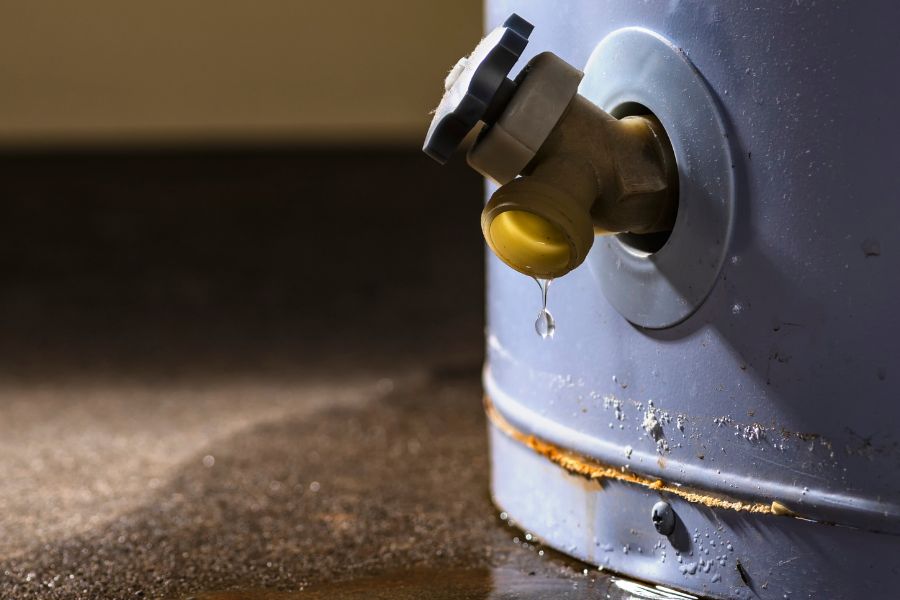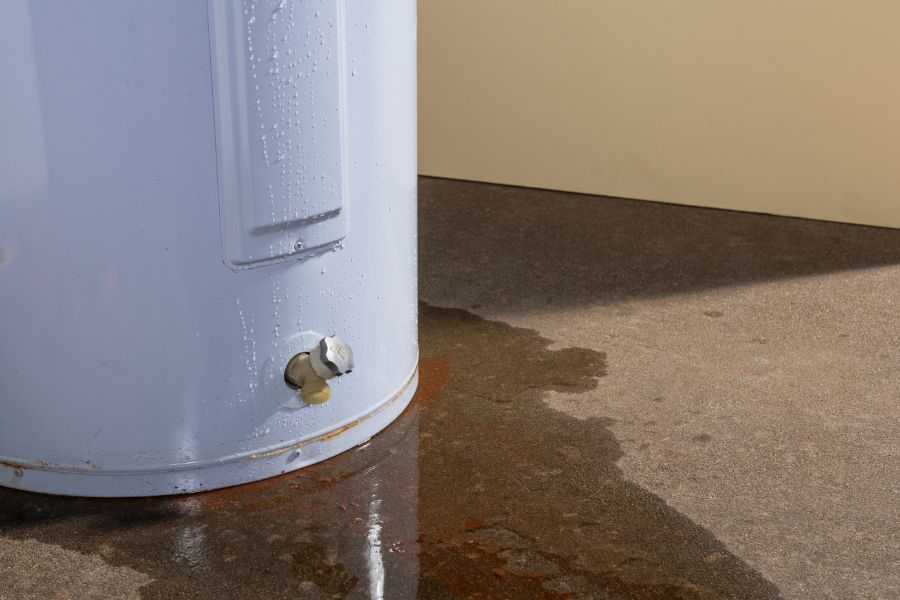If you’re facing a leaky water heater in Granbury, TX, promptly address the issue. Identifying the source of the leak is your first step, and several effective solutions exist. Each option can help you regain control over your home’s hot water situation, from checking valves to evaluating a replacement. But what’s the most common mistake homeowners make when tackling this issue? Let’s find out.
Identify the Source of the Leak
How can you effectively identify the source of a leak in your water heater? Start by inspecting the area around the heater for puddles or damp spots. Look closely at the connections, pipes, and tank. Check for corrosion or rust, as these can indicate a problem.
If you find a leak, feel the temperature of the water; hot spots usually mean the leak is from the tank itself.
Next, examine the inlet and outlet pipes for any moisture. Tighten any loose connections to see if that resolves the issue. You should also inspect the drain valve, as leaks often occur there.
Don’t forget to check the floor underneath the heater, as water may pool in unexpected places. If you notice any ongoing issues, consider contacting a professional plumber for reliable water heater services, as they can pinpoint the source and provide the necessary repairs, ensuring your water heater operates safely and efficiently.
Check the Temperature and Pressure Relief Valve
Checking the temperature and pressure relief valve is essential when dealing with a leaky water heater. You need to verify the valve is functioning correctly and that the pressure settings are appropriate. A malfunctioning valve can lead to more serious issues, so don’t overlook this important step. Additionally, consider consulting with licensed technicians who can provide expert assistance and ensure the problem is properly addressed.
Valve Functionality Check
A well-functioning temperature and pressure relief valve is essential for your water heater’s safety and efficiency.
To check its functionality, locate the valve on the side or top of your heater. Gently lift the lever to release a small amount of water. If water flows freely and then stops when you release the lever, the valve is working properly.
However, if water continues to leak or the valve feels stuck, it may need replacement. Regular checks will help prevent pressure buildup, which can lead to leaks or even dangerous situations.
If you’re unsure or need assistance, don’t hesitate to call Benjamin Franklin Plumbing of Fort Worth for expert help and reliable service.
Proper Pressure Settings
Guaranteeing proper pressure settings is essential for the safe operation of your water heater.
Start by checking the temperature and pressure relief valve (T&P valve), which helps prevent excessive pressure buildup. If the valve is faulty or not set correctly, it can lead to leaks or even dangerous explosions.
You should set the pressure to a safe level, typically around 50-60 psi. Regularly test the T&P valve by lifting the lever; if water doesn’t flow or if it drips continuously, it’s time for a replacement.
Don’t hesitate to reach out to professionals like Benjamin Franklin Plumbing of Fort Worth for expert assistance. They’ll guarantee your water heater operates safely and efficiently, giving you peace of mind.
Inspect the Drain Valve
When you inspect the drain valve, start by checking for clogs that could be causing leaks.
If everything looks clear, tighten any loose connections to guarantee a snug fit.
Addressing these issues can prevent further water damage and keep your water heater running smoothly. Additionally, consider scheduling regular maintenance and prevention to ensure your plumbing system remains in optimal condition.
Check for Clogs
Clogs can be a sneaky culprit behind a leaky water heater, often hiding in the drain valve. Checking for clogs is an essential first step when you notice water pooling around your heater.
Here’s what to look for:
- Debris Buildup: Sediment can accumulate in the valve, causing blockages.
- Rust: Corrosion might obstruct the flow, leading to leaks.
- Mineral Deposits: Hard water can leave deposits that restrict water movement.
- Valve Damage: A broken or malfunctioning valve can create leaks, even without clogs.
Tighten Loose Connections
One of the critical steps in addressing a leaky water heater is to tighten any loose connections, especially around the drain valve.
Start by scrutinizing the valve; look for any signs of water leakage or rust. If you notice any drips, it’s a clear indicator that the valve mightn’t be secure.
Using a wrench, gently tighten the valve clockwise until it feels snug, but avoid over-tightening, as this could damage the valve.
After tightening, check for leaks again by running the water heater. If the leak persists, you may need to replace the valve entirely.
Examine the Tank for Corrosion
Corrosion is a common culprit behind leaky water heaters, so it’s important to examine the tank regularly. Ignoring this issue can lead to costly repairs or even a complete replacement. Here’s what you should look for:
- Rust spots: Notice any brown or orange stains? They signal that corrosion is starting to take hold.
- Pitting: Small dents or holes on the tank’s surface indicate serious corrosion. Don’t let it go unchecked!
- Leaking water: If you spot water pooling around the base, it’s a clear sign that corrosion might be at play.
- Age of the heater: If your water heater’s over ten years old, it’s time to inspect for corrosion before it becomes a bigger problem. Additionally, regular inspections can help prevent future plumbing issues that may arise from undetected leaks.
Tighten Loose Connections
Inspect all connections for any signs of looseness when dealing with a leaky water heater.
Tightening these connections can often resolve the issue quickly and effectively.
Use the proper tools to guarantee a secure fit and prevent future leaks.
Inspect All Connections
Inspecting all connections is vital to preventing leaks in your water heater. Over time, connections can loosen, leading to frustrating and costly leaks.
You can avoid this hassle by regularly checking these areas:
- Water supply line – Loose connections here can cause significant leaks, wasting water and money.
- Drain valve – If this isn’t tight, you might find water pooling underneath your unit.
- Temperature and pressure relief valve – A loose connection can lead to dangerous pressure buildup.
- Heating element gaskets – Verify these are secure to prevent leaks from the heating elements.
Use Proper Tools
Using the right tools is essential for tightening loose connections on your water heater effectively. Start with a wrench or pliers, guaranteeing they fit snugly around the fittings.
If you notice any corrosion or damage, replace the parts before tightening to avoid further issues. When you grasp the connection, apply steady pressure, but don’t over-tighten, as this could cause leaks or damage.
If you’re unsure about your tools or techniques, consider contacting a professional. At Benjamin Franklin Plumbing of Fort Worth, we’re ready to assist you with any water heater issues.
Our trained technicians have the right tools and expertise to guarantee your connections are tight and secure, giving you peace of mind.
Replace the Anode Rod
One effective way to extend your water heater’s life is by regularly replacing the anode rod. This simple maintenance task can save you from costly repairs or replacements down the line.
The anode rod attracts corrosive elements in the water, protecting the tank from rust and deterioration.
Here are four reasons why you should prioritize replacing the anode rod:
- Prevents Corrosion: Keeps your tank safe from rust, extending its lifespan.
- Saves Money: Avoids expensive repairs or a full water heater replacement.
- Improves Efficiency: A well-maintained water heater operates more effectively, lowering energy bills.
- Peace of Mind: Knowing your water heater is protected means less worry and hassle for you.
Regularly checking and replacing the anode rod is a small yet powerful step toward ensuring your water heater runs smoothly for years to come.
Ensure Proper Insulation
Proper insulation is essential for maintaining your water heater’s efficiency and longevity, especially when it comes to preventing heat loss. By ensuring your water heater is properly insulated, you reduce energy consumption and save on utility bills.
Start by checking the insulation around the tank itself; it should be thick enough to prevent heat from escaping. If you notice any gaps or damage, consider adding an insulation blanket designed specifically for water heaters.
Don’t forget about the pipes as well—insulating them helps maintain water temperature and reduces the risk of leaks due to condensation.
Inspect the area around your water heater for drafts or cold spots that could affect its efficiency. By taking these steps, you’ll not only extend the life of your unit but also enhance its performance, ensuring your hot water needs are met efficiently and effectively.
Consider a Water Heater Replacement
Have you noticed a decline in your water heater’s performance or an increase in energy bills? It might be time to contemplate a replacement. An aging water heater can drain your resources and leave you with lukewarm showers.
Think about the benefits of a new unit:
- Enhanced Efficiency: New models use less energy, cutting down your bills.
- Consistent Hot Water: No more cold surprises during your morning routine.
- Space Savings: Modern designs are often more compact, freeing up room.
- Peace of Mind: A new system reduces the risk of leaks and costly repairs.
Replacing your water heater can seem overwhelming, but it’s an investment in your home’s comfort and efficiency.
Don’t let an unreliable unit disrupt your daily life. If you’re ready to take the plunge, reach out to professionals who can guide you through the process.
Schedule Regular Maintenance
When you schedule regular maintenance for your water heater, you can catch potential issues before they escalate into costly repairs.
Regular checks help guarantee that all components are functioning efficiently, which can extend the lifespan of your unit. During these maintenance visits, a technician will inspect for leaks, test pressure relief valves, and flush the tank to remove sediment buildup.
This proactive approach not only keeps your water heater running smoothly but also increases energy efficiency, potentially lowering your utility bills.
Knowing that your system is in top shape, you’ll also gain peace of mind.
Don’t wait for a problem to arise; make maintenance a priority. By establishing a routine, you’re investing in the reliability of your water heater and protecting your home from unexpected leaks.
Contact a Professional Plumber
If you notice any signs of a leaky water heater, contacting a professional plumber is crucial. Delaying action can lead to more significant issues, such as water damage or mold growth.
Trusting an expert guarantees you receive the best care for your plumbing needs.
Here are four reasons to reach out to a professional plumber:
- Expert Diagnosis: Professionals can quickly identify the root cause of the leak, saving you time and stress.
- Safety Assurance: Handling plumbing issues can be risky. Experts know how to manage potential hazards safely.
- Long-term Solutions: A skilled plumber provides durable repairs, preventing future leaks and costly repairs.
- Peace of Mind: With an experienced technician on the job, you can relax knowing your water heater is in capable hands.
Don’t let a leak disrupt your home.
Contact Benjamin Franklin Plumbing of Fort Worth for reliable service today!

Conclusion
To summarize, addressing a leaky water heater in Granbury, TX, involves a few proactive steps. For example, a local homeowner noticed a small leak and tightened the connections, which resolved the issue without further complications. By regularly inspecting your unit and scheduling maintenance, you can prevent larger problems and save on energy costs. If the leak persists, don’t hesitate to contact a professional plumber for expert help to guarantee your water heater runs smoothly.

